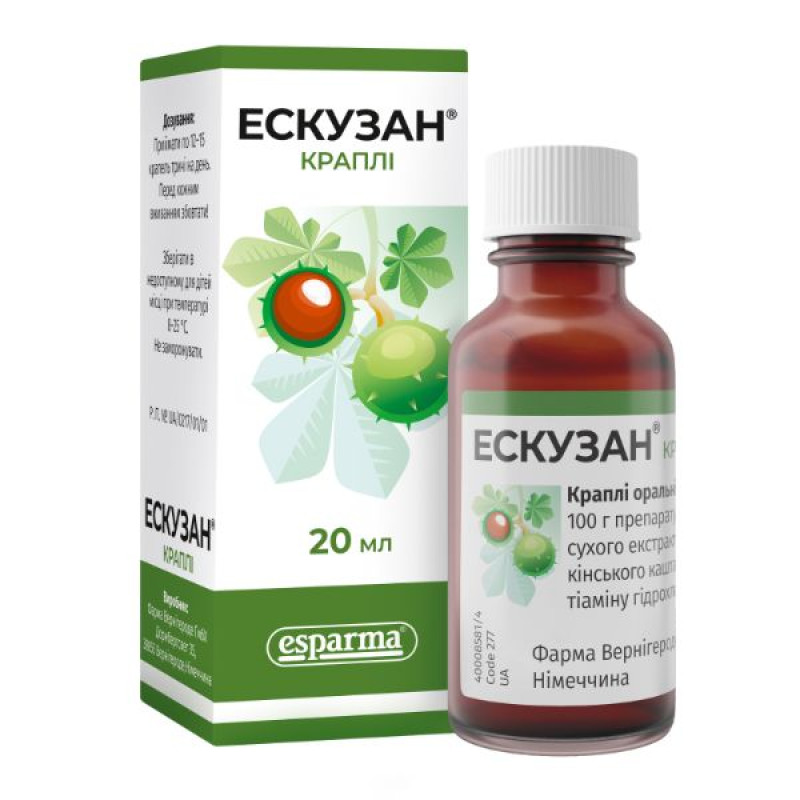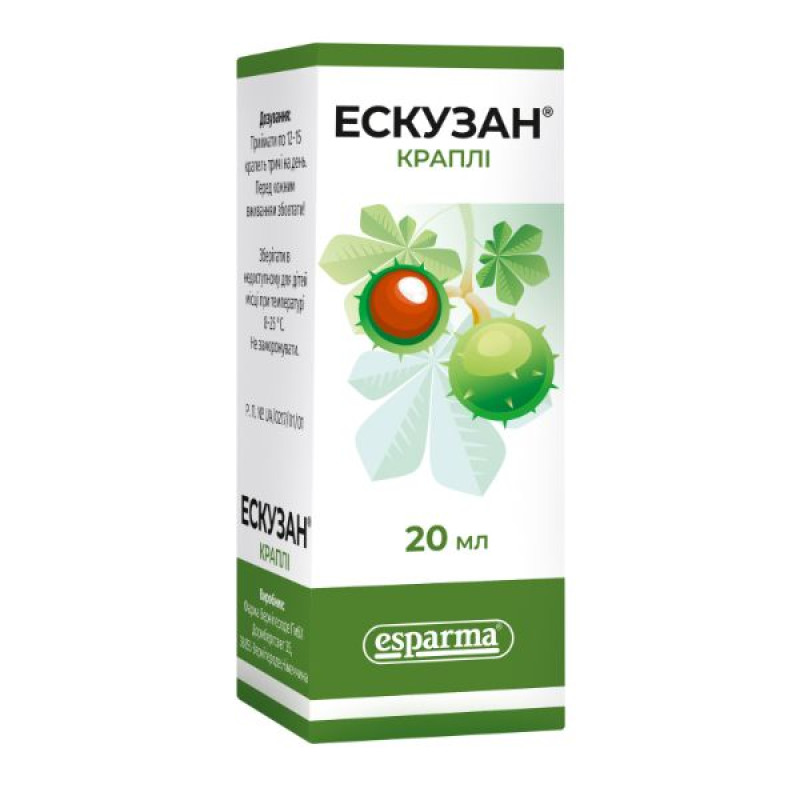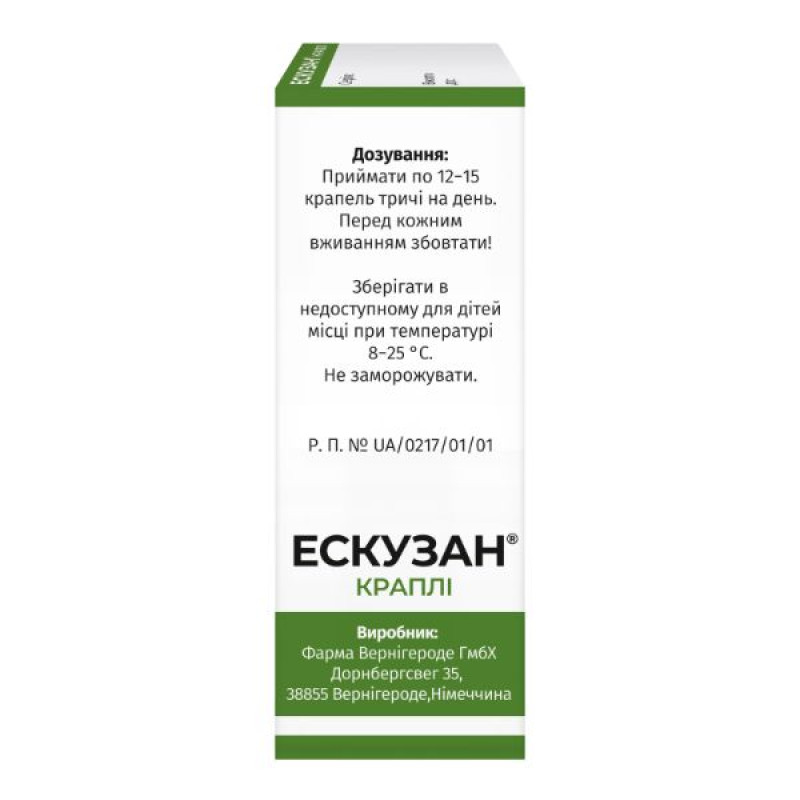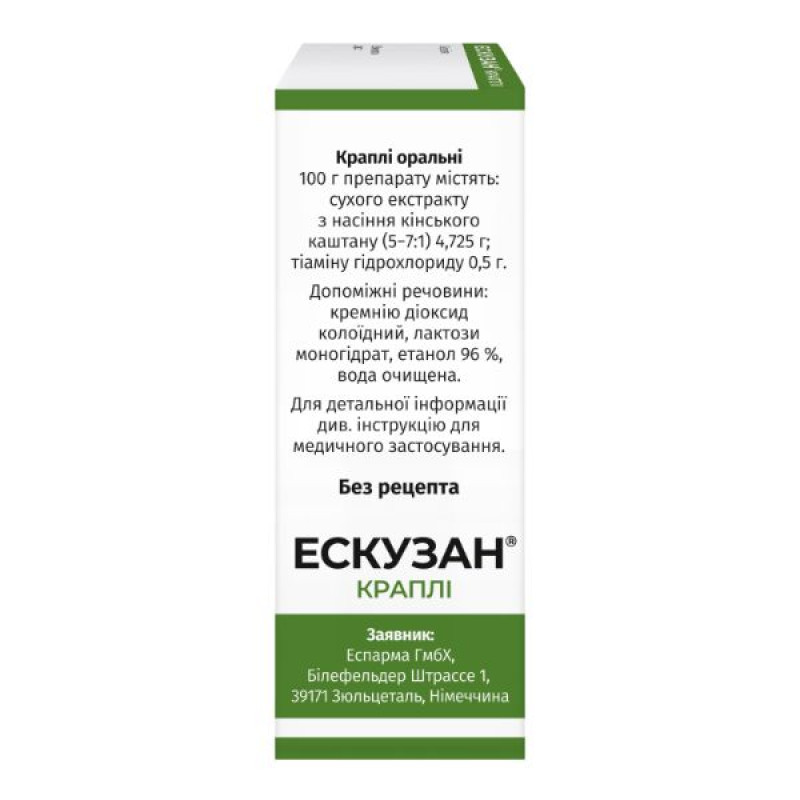Escuzan oral drops bottle 20 ml

Instructions for use Escuzan oral drops, 20 ml bottle
Composition
active ingredients: 100 g of solution contain 4.725 g of dry extract from horse chestnut seeds (Hippocastani extractum siccum normatum) (5-7:1) [extractant ethanol 60% (v/v)], 0.5 g of thiamine hydrochloride;
excipients: ethanol 96%, purified water, lactose monohydrate, colloidal silicon dioxide.
Dosage form
Oral drops.
Main physicochemical properties: transparent or slightly cloudy liquid from yellow to reddish-brown color with a characteristic odor. During storage, sediment may form.
Pharmacotherapeutic group
Capillary stabilizing agents. ATX code C05C X.
Pharmacological properties
Pharmacodynamics
The mechanism of action of escin, which is contained in horse chestnut seeds, is due to the stabilization of lysosomal membranes, inhibition of the release of autolytic cellular enzymes, as a result of which the breakdown of mucopolysaccharides is reduced and trophic processes in the walls of venous vessels and adjacent connective tissue are improved. The drug reduces pathologically increased vascular-tissue permeability, preventing transcapillary filtration of low-molecular proteins, electrolytes and water into the intercellular space, increases the tone of the venous wall, eliminates venous congestion (especially in the lower extremities), reduces peripheral edema, reduces the feeling of heaviness in the legs, fatigue, tension, itching, pain.
Thiamine hydrochloride in the body is converted into active thiamine diphosphate, participates in carbohydrate and energy metabolism, and is a coenzyme in many enzyme reactions.
Pharmacokinetics
When taken orally, escin is rapidly absorbed, mainly from the duodenum. It is subject to a pronounced "first pass" effect through the liver. In tissue fluid and blood plasma, escin binds to proteins (approximately 84%) and cholesterol. It is metabolized in the liver. It is excreted from the body with urine and bile in the form of metabolites.
Indication
Chronic venous insufficiency:
swelling;
calf muscle cramps;
itching, as well as pain and a feeling of heaviness in the legs;
varicose veins.
Postthrombotic syndrome.
Trophic changes in the veins of the lower extremities, such as shin ulcers.
Hemorrhoids.
Prevention and treatment of post-traumatic and postoperative edema and hematomas.
Contraindication
Hypersensitivity to the components of the drug. Renal failure, allergic diseases.
Interaction with other medicinal products and other types of interactions
The drug may enhance the effect of antithrombotic agents. Cephalosporin antibiotics increase the concentration of free escin in the blood and the risk of side effects. The simultaneous use of the drug with aminoglycoside antibiotics should be avoided due to increased toxic effects of aminoglycosides on the kidneys.
Thiosemicarbazone and 5-fluorouranil, as well as simultaneous infusion of solutions containing sulfites, inhibit thiamine activity.
Application features
If you experience unusual symptoms in your legs (swelling, skin discoloration, feeling of tightness or heat), as well as pain, you should consult a doctor immediately, as these symptoms may indicate serious medical complications (deep vein thrombosis, i.e. blockage of the veins in your legs by a blood clot).
It is imperative to follow the non-invasive treatment methods prescribed by the doctor (applying compresses, wearing supportive elastic stockings, dousing with cold water).
The medicine contains a small amount of ethanol (less than 100 mg/dose).
This medicinal product contains lactose. If you have been told by your doctor that you have an intolerance to some sugars, contact your doctor before taking this medicinal product.
During use of the drug, kidney function should be monitored.
The use of thiamine in high doses may distort the results of the determination of theophylline in serum by the spectrophotometric method and urobilinogen using Ehrlich's reagent.
Use during pregnancy or breastfeeding
The drug is not recommended for use during pregnancy or breastfeeding due to insufficient data on the safety of its use in this category of patients.
Ability to influence reaction speed when driving vehicles or other mechanisms
Does not affect.
Method of administration and doses
It is recommended to take 12-15 drops 3 times a day before meals, with a small amount of liquid. The course of treatment is from 2 weeks to 2-3 months.
Due to the possible presence of sediment of plant origin, it is recommended to shake the product before use.
Children
Do not use on children.
Overdose
Treatment. Symptomatic. If a large amount of horse chestnut fruit extract has been ingested and there is no vomiting, gastric lavage (for example, with a 0.02% solution of potassium permanganate) and administration of activated charcoal are recommended.
Side effects
Cardiovascular system: tachycardia, palpitations, hypotension
From the nervous system: headache, dizziness.
On the part of the digestive tract: dyspeptic phenomena, pain in the epigastric region, nausea, diarrhea, vomiting.
Immune system disorders: hypersensitivity reactions, including urticaria, rash, itching, feeling of heat, angioedema, shock.
In the case of using high doses of the drug, nephrotoxic reactions and thrombosis are possible.
Expiration date
3 years.
Storage conditions
Store out of the reach of children at a temperature of 8-25 ° C. Do not freeze.
Packaging
20 ml in a bottle with a dropper, 1 bottle in a cardboard box.
Vacation category
Without a prescription.
Producer
Pharma Wernigerode GmbH, Germany.
Address
Dornbergsweg 35, 38855 Wernigerode, Germany.
Applicant
Esparma GmbH.
Applicant's location
Bielefelder Strasse 1, 39171 Sulzetal, Germany.
There are no reviews for this product.
There are no reviews for this product, be the first to leave your review.
No questions about this product, be the first and ask your question.







